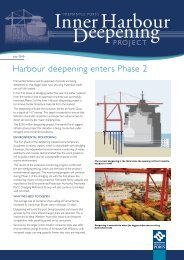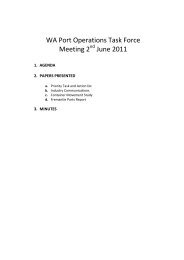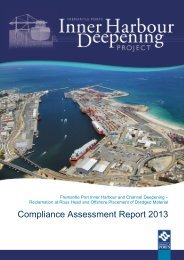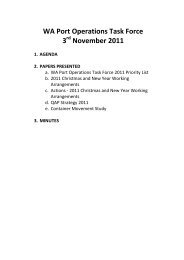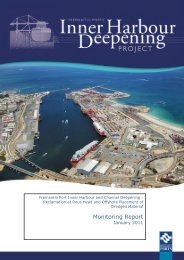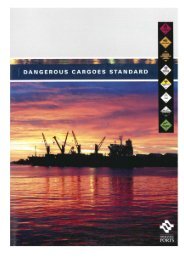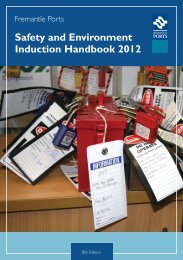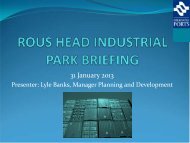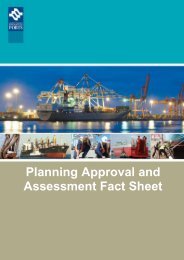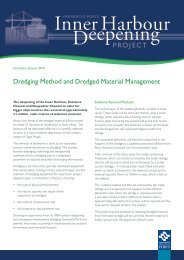Fremantle Port Inner Harbour and Channel ... - Fremantle Ports
Fremantle Port Inner Harbour and Channel ... - Fremantle Ports
Fremantle Port Inner Harbour and Channel ... - Fremantle Ports
- No tags were found...
You also want an ePaper? Increase the reach of your titles
YUMPU automatically turns print PDFs into web optimized ePapers that Google loves.
Sediment nutrients <strong>and</strong> metalsNutrient <strong>and</strong> metals data were analysed by zone, with sites being nested (n=5). Univariateanalysis was a two factor design: zone (undisturbed, transition or disturbed) <strong>and</strong> site (1-5).Multivariate analysis was conducted using 'BEST' analysis in PRIMER to assess the correlationof whole sediment nutrients <strong>and</strong> metals versus either a single variable (P. angustifolia shootdensity or percentage cover) or multiple variables (percentage cover of biota categories) (seeTable 2.2). Concentrations of whole sediment nutrient <strong>and</strong> metals were normalised <strong>and</strong>st<strong>and</strong>ardised to positive values prior to running the 'BEST' analysis (Clarke <strong>and</strong> Gorley 2006).'BEST' analysis was limited to five best correlations using a stepwise comparison.2.5 QA/QCQuality assurance <strong>and</strong> quality control (QA/QC) procedures were in accordance with thosedescribed in the EPA (2005) Manual of St<strong>and</strong>ard Operating Procedures for EnvironmentalMonitoring against the Cockburn Sound Environmental Quality Criteria (2003 – 2004) (SOP)<strong>and</strong> ANZECC/ARMCANZ (2000) Australian Guidelines for Water Quality Monitoring <strong>and</strong>Reporting, as described below.2.5.1 Quality assurance <strong>and</strong> quality control in field samplingA QA/QC program was implemented prior to data collection <strong>and</strong> continued to the finalreporting stage, including procedures designed to prevent, detect <strong>and</strong> correct problems in theprocess of operations. It included processes to ensure adherence to protocols, calibration offield instruments <strong>and</strong> records of field observations.Method StatementsMethod Statements were produced to detail the sampling processes <strong>and</strong> assist futuresampling campaigns in the form of:dive operations gear list;site diagrams;sediment sampling logs;seagrass survey statement (outlines shoot counts <strong>and</strong> video procedures for divers); <strong>and</strong>'TransectMeasure' quick guide (outlines specific video processing tasks for this project).Recording of field proceduresComplete records of all field procedures were maintained, including:updated site locations (data for relocation with GPS coordinates);verification of data collected (number of video, photographs <strong>and</strong> data sheets);record of dive profile including personnel, gas used, time, date <strong>and</strong> site number;collection of metadata (general site photographs);daily operations reports (including record of safety meetings); <strong>and</strong>a field operations summary report.Any circumstances potentially affecting data collection procedures were documented <strong>and</strong>corrected for future operations.Maintenance <strong>and</strong> calibration of field equipmentAll equipment <strong>and</strong> field instruments were kept clean <strong>and</strong> in good working order. Calibrations,preventative maintenance actions <strong>and</strong> pre-dive checks were carried out according to predefinedschedules <strong>and</strong> procedures. Video cameras were tested for required height (0.84 m)from seabed to produce a 0.5 m belt width along a transect (necessary due to the refractionof water). All camera settings (i.e. exposure, pixel quality, etc.) were verified as correct priorto the diver entering the water.Oceanica: <strong>Fremantle</strong> <strong>Port</strong>s: FP – Gage Roads Offshore Disposal Area Seagrass Recovery Project, Phase I – Initial Survey 17



